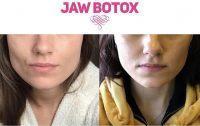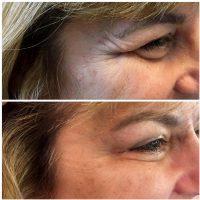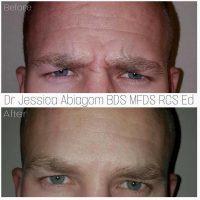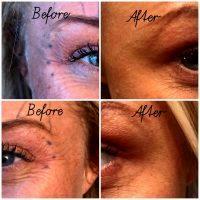What Areas Can You Have Botox?
Botox for the face
Botox and other neuromodulators are effective in areas where there are dynamic wrinkle.
These are wrinkles due to facial expression. Common areas of Botox include the forehead for the horizontal lines across, glabella for the 11’s between the eyebrows, brows to elevate the brows, crow feet for the smile lines around the eyes, bunny lines on the side of the nose, nose for flares and to lift the tip, vertical lines above the lips, jawline to slim the face, platysma for the neck band, and chin for dimpling.
Botox can also be injected around the mouth to lift the corner of the lips. When injected around the mouth, care should be taken to not affect the smile. (Laura Phan, MD, Los Gatos Physician)

Botox Crows Feet By Timothy Minton, Savannah Plastic Surgeon
Areas of the face that can be injected with botox
Most commonly botox is injected into the upper face – helping to soften the appearance of frown, forehead and smile lines / crows feet. Treating dynamic lines, or the lines that appear when moving muscles of the face.
Treatment results are usually dependant on the depth of the wrinkle. Sometimes a combination of botox and dermal fillers can be used to re-volumise and improve lines ‘all over the face’ and deeper lines. I also use skin boosters / or very soft hyaluronic acid injected at a more superficial depth to soften very light wrinkles too.
More advanced procedures that I offer at my London clinic improve other less commonly treated areas:
- Brow lift with botox
- Botox to reduce the appearance of a gummy smile
- Smile symmetry correction
- Perioral / smokers lines around the mouth
- Under eye botox / subtle injections around the lower eye lid that soften fine lines
- Botox for bunny lines
- Botox for nasal flaring muscles.
- Nefertiti neck lift
- Botox in the masseter muscle to improve square shaped jaw
- Botox in muscles around mouth – commonly DAO muscle that can up slant mouth corners.
I hope this gives you an idea about other possibilities. (Rupert Critchley, MD, MRCGP, London Physician)
Botox: Injection Everywhere?
There are FDA indications for Botox snd dysport and off-label uses of the medications. Where ever there is a muscle, an injection of the muscle relaxants may work to give a clinical benefit.
1. Most commonly, injections of the Forehead, between the eyes (glabella) and lateral side of the eye (crows feet).
2. Secondary sites include:
- Below the lower eyelid for fine wrinkles (limit to 6-8 units)
- Along the lateral cheek adjacent to crows feet wrinkles- caution with the units injected so facial drooping does not occur, but with adequate wrinkle improvement.
- Upper lip (bout 8 units) for excess dental show (gummy smile).
- Chin muscle (mentalis) wrinkles
- Wrinkles on nose (bunny lines)- usually 5 u per side
- Neck (platsymal) muscle banding- usually 15-20 units per side
3. Headache injections: temporal and occipital muscles
4. Masseter muscles for TMJ or myofascial pain syndrome (25 units per side)
5. Hyperhydrosis or excess sweating of the hands and under arm (axilla)- about 50 units per site
Remember: it is better to inject less than more, you can always put more in, you cannot take it away. (Robert J. Troell, MD, FACS, Las Vegas Facial Plastic Surgeon)

Jaw Botox Pre And Post
BOTOX Areas that can be treated
Botox is FDA approved for cosmetic treatment of muscles that cause facial wrinkling to the forehead, lateral to eyes (“crows feet”) and between the eyebrows (“11’s”).
Botox treatment of these regions can significantly improve lines to the skin caused by dynamic movement of muscles as well as “lift” the eyes through strategic placement of product.
In addition to upper face, advanced practice clinicians use Botox to treat lines to the nose (“bunny lines”), areas around the mouth, above lip and the chin. These advance techniques can soften lines and improve symmetry but require mastery of facial anatomy so be sure to see a board certified plastic surgeon or expert injector with lots of experience for these off label uses. (Bradley Bengtson, MD, FACS, Grand Rapids Plastic Surgeon)

Relaxing Different Facial Muscles
Botox is primarily used to treat 11 Lines and Crow’s Feet
The most effective areas to treat with Botox are around the corners of the eyes (also known as “crow’s feet”) and between the eyes (also known as “11 lines.”) (Stephen P. Bracci, MD, New York Physician)
Where can Botox be injected?
Botox is most commonly used in the upper 1/3 of the face (forehead, crow’s feet, and glabella). Botox can also be used for the “bunny lines” at the sides of the nose, lower eyelid wrinkles (in select patients), vertical neck banding, and downturned corners of the mouth.
Many of these injection locations are technically “off-label” uses and should not be performed by novice injectors. Botox injections around the mouth can also be risky, and are not something that I typically advocate as they can negatively affect the normal ability to smile and articulate.

Where On The Face Can BOTOX Be Injected
For static wrinkles on certain areas of the face, fillers or some sort of resurfacing (lasers, chemical peels, etc) may be more appropriate. Always see an expert physician injector who specializes in facial aesthetics. (Matthew Richardson, MD, Frisco Facial Plastic Surgeon)
Where on the face Botox can be injected.
Botox is an excellent anti-wrinkle treatment and has many benefits in the upper and lower parts of the face. Botox is most commonly applied to the wrinkles in the upper part of the face where muscular contraction has caused lines to settle into the skin.
Wrinkles can be caused by multiple factors and an experienced medical aesthetic practitioner will assess the reason for your wrinkles. In some cases, it may be more appropriate to improve the skin elasticity to tighten, or to replace volume to lift, both approaches also treat wrinkles.

Wrinkles Can Be Minimised
Some highly specialist uses of Botox can be applied to adjust the smile or jawline in the lower zones of the face. As always, the best advice is to seek a highly qualified and dedicated aesthetic medical practitioner who can guide you towards the most appropriate options and results for you. (Tracy Mountford, MBBS, London Physician)
Where Botox is used
Botox is a purified protein used to address wrinkles associated with facial expression. Botox is now widely known to treat wrinkles. However it cannot address all wrinkles, only certain ones, namely those that are associated with muscle movement.
The most common areas treated with Botox are the horizontal lines on the upper forehead seen when one raises the brows, the vertical lines between the brows seen when one frowns, and the crow’s feet seen around the eyes when one smiles or squints.
There are a number of other places in the mid- and lower-face as well as the neck that Botox can be used. Fillers such as Voluma and Vollure can be used to address nasolabial folds, the wrinkles that go from the sides of the nose to the corners of the mouth.
Fractional CO2 laser resurfacing can be used to address diffuse fine lines and loose or saggy skin. Please consult with a doctor for specific recommendations. (Alex Eshaghian, MD, PhD, Encino Physician)
Where would Botox be suited safe and effective
Botox and the other neurotoxin injectables (such as Dysport and Xeomin) are used to treat lines that appear with movement. For example when you raise your eyebrows, horizontal lines appear across the forehead. When you frown vertical lines appear between the eyebrows.

Botox Frown Lines By Jessica Abiagom
When you squint lines at the corners of the eyes appear (called crows feet). When you purse your lips or drink from a straw vertical lines appear around the lips. Additionally some people are concerned about prominent or wide appearing jaw, this may be due to hypertrophied master muscle or parotid glands both of which can be treated with botox (in an off label indication) to decrease their size and prominence.
All of these can be treated effectively with Botox. However if it is injected incorrectly, temporary complications can occur such as eyelid droop or inability to fully close the mouth. Make sure you see a board certified professional for your injections. (Catherine Weng, MD, Denver Otolaryngologist)
Botox use in wide spread wrinkling
Unfortunately once wide spread wrinkling has occurred Botox is usually not likely to be of much help. The wrinkling has over time become so ingrained that Botox probably will not help. Try spreading the wrinkles with your fingers.
If it will not make the wrinkle disappear Botox will be unlikely to be of much benefit. (Maurice M. Vick, Jr., MD, Baton Rouge Urologist)
What areas of the face does Botox treat?
Botox is FDA approved to treat frown lines and crow’s feet. However, Botox is used as off label use to treat the following areas:
- Forehead Bunny lines (lines on the nose)
- Elevate the corners of the mouth
- Chin dimples
- Platysmal bands (neck lines)
- Sweating to arm pits, hands and feet
- Sweating to forehead and scalp (Bernard S. Salameh, MD, Bowling Green Physician)
